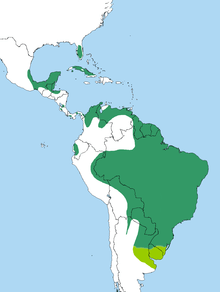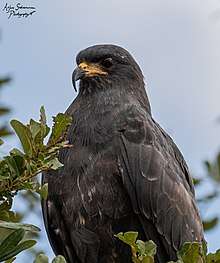Snail kite
The snail kite (Rostrhamus sociabilis) is a bird of prey within the family Accipitridae, which also includes the eagles, falcons, hawks, and Old World vultures. Its relative, the slender-billed kite, is now again placed in Helicolestes, making the genus Rostrhamus monotypic. Usually, it is placed in the milvine kites, but the validity of that group is under investigation.
| Snail kite | |
|---|---|
| Adult male | |
_female.jpg) | |
| Adult female, Panama | |
| Scientific classification | |
| Kingdom: | Animalia |
| Phylum: | Chordata |
| Class: | Aves |
| Order: | Accipitriformes |
| Family: | Accipitridae |
| Genus: | Rostrhamus Lesson, 1830 |
| Species: | R. sociabilis |
| Binomial name | |
| Rostrhamus sociabilis (Vieillot, 1817) | |
 | |
| Range of R. sociabilis All-year resident Breeding only range Area of breeding and vagrancy | |
Description
.jpg)
Snail kites are 36 to 48 cm (14 to 19 in) long with a 99–120 cm (39–47 in) wingspan. They weigh from 300 to 570 g (11 to 20 oz).[2][3] There is very limited sexual dimorphism, with the female averaging only 3% larger than the male. They have long, broad, and rounded wings, which measure 29–33 cm (11–13 in) each. Its tail is long, at 16–21 cm (6.3–8.3 in), with a white rump and undertail coverts. The dark, deeply hooked beak, measuring 2.9–4 cm (1.1–1.6 in) is an adaptation to its diet. The tarsus is relatively long as well, measuring 3.6–5.7 cm (1.4–2.2 in).[3]
The adult male has dark blue-gray plumage with darker flight feathers. The legs and cere are red. The adult female has dark brown upperparts and heavily streaked pale underparts. She has a whitish face with darker areas behind and above the eye. The legs and cere are yellow or orange. The immature is similar to adult female, but the crown is streaked.
It flies slowly with its head facing downwards, looking for its main food, the large apple snails. For this reason, it is considered a molluscivore.
Taxonomy
Lerner and Mindell (2005) found R. sociabilis sister to Geranospiza caerulescens, and that those two along with Ictinea plumbea were basal to both the buteogallus and buteo clades. They concluded that Rostrhamus belonged in Buteoninae (sensu stricto) and not in Milvinae, but noted that more investigation was needed.[4]
Distribution and ecology
The snail kite breeds in tropical South America, the Caribbean, and central and southern Florida in the United States. It is resident all-year in most of its range, but the southernmost population migrates north in winter and the Caribbean birds disperse widely outside the breeding season.
It nests in a bush or on the ground, laying 3–4 eggs.
The snail kite is a locally endangered species in the Florida Everglades, with a population of less than 400 breeding pairs. Research has demonstrated that water-level control in the Everglades is depleting the population of apple snails.[5] However, this species is not generally threatened over its extensive range.

In fact, it might be locally increasing in numbers, such as in Central America. In El Salvador, it was first recorded in 1996. Since then, it has been regularly sighted, including immature birds, suggesting a resident breeding population might already exist in that country. On the other hand, most records are outside the breeding season, more indicative of post-breeding dispersal. In El Salvador, the species can be observed during the winter months at Embalse Cerrón Grande, Laguna El Jocotal, and especially Lago de Güija. Pomacea flagellata apple snails were propagated in El Salvador between 1982 and 1986 as food for fish stocks, and it seems that the widespread presence of high numbers of these snails has not gone unnoticed by the snail kite.[6]
This is a gregarious bird of freshwater wetlands, forming large winter roosts. Its diet consists almost exclusively of apple snails.
Snail kites have been observed eating other prey items in Florida, including crayfish in the genus Procambarus and black crappie. It is believed that snail kites turn to these alternatives only when apple snails become scarce, such as during drought,[7] but further study is needed. On 14 May 2007, a birdwatcher photographed a snail kite feeding at a red swamp crayfish farm in Clarendon County, South Carolina.[8][9]
References
- BirdLife International (2012). "Rostrhamus sociabilis". IUCN Red List of Threatened Species. 2012. Retrieved 26 November 2013.CS1 maint: ref=harv (link)
- "Snail Kite". All About Birds. Cornell Lab of Ornithology.
- Ferguson-Lees, J.; Christie, David A. (2001). Raptors of the world: Snail Kite. Houghton Mifflin. pp. 363–365. ISBN 978-0618127627.
- Lerner, H.R.L.; Mindell, D.P. (2005). "Phylogeny of eagles, Old World vultures and other Accipitridae based on nuclear and mitochondrial DNA" (PDF). Molecular Phylogenetics and Evolution. 37 (2): 327–346. doi:10.1016/j.ympev.2005.04.010. PMID 15925523.
- "Lake Okeechobee Low Lake Stage Restoration Projects". Archived from the original on 4 June 2010.
- Herrera, Néstor; Rivera, Roberto; Ibarra Portillo, Ricardo; Rodríguez, Wilfredo (2006). "Nuevos registros para la avifauna de El Salvador" [New records for the avifauna of El Salvador] (PDF). Boletín de la Sociedad Antioqueña de Ornitología (in Spanish and English). 16 (2): 1–19.
- Davis, Steven M.; Ogden, John C. (1994). Everglades: The Ecosystem and its Restoration. CRC Press. p. 508. ISBN 978-0-9634030-2-5.
- Pogatchnik, Shawn (12 June 2007). "Bird watcher spots snail kite in S.C." News Room Media. Associated Press. Archived from the original on 23 May 2007. Retrieved 30 July 2009.
- "Everglade Snail Kite discovered near Rimini, SC". Cape Romain Bird Observatory. Retrieved 30 July 2009.
External links
| Wikimedia Commons has media related to Rostrhamus sociabilis. |
| Wikispecies has information related to Rostrhamus sociabilis |
- Snail Kite Information at Great Florida Birding & Wildlife Trail
- BirdLife species factsheet for Rostrhamus sociabilis
- "Rostrhamus sociabilis". Avibase.

- "Snail kite media". Internet Bird Collection.
- Snail kite photo gallery at VIREO (Drexel University)
- Interactive range map of Rostrhamus sociabilis at IUCN Red List maps
- Audio recordings of Snail kite on Xeno-canto.
